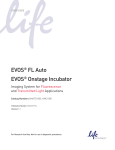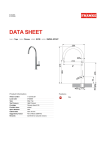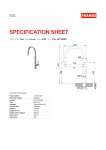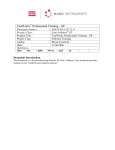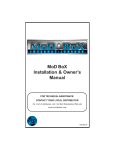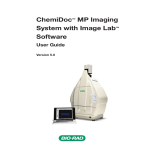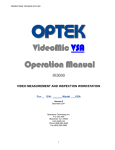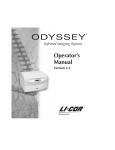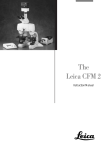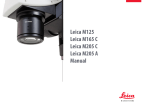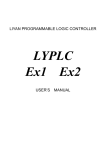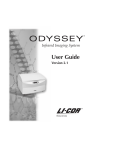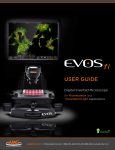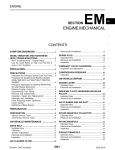Download User Manual - Thermo Fisher Scientific
Transcript
user guide EVOS® FL Auto Imaging System for Fluorescence and Transmitted Light Applications Catalog Numbers AMAFD1000 Publication Number MAN0007986 Revision 3.0 For Research Use Only. Not for use in diagnostic procedures. Information in this document is subject to change without notice. DISCLAIMER LIFE TECHNOLOGIES CORPORATION AND/OR ITS AFFILIATE(S) DISCLAIM ALL WARRANTIES WITH RESPECT TO THIS DOCUMENT, EXPRESSED OR IMPLIED, INCLUDING BUT NOT LIMITED TO THOSE OF MERCHANTABILITY, FITNESS FOR A PARTICULAR PURPOSE, OR NON-INFRINGEMENT. TO THE EXTENT ALLOWED BY LAW, IN NO EVENT SHALL LIFE TECHNOLOGIES AND/OR ITS AFFILIATE(S) BE LIABLE, WHETHER IN CONTRACT, TORT, WARRANTY, OR UNDER ANY STATUTE OR ON ANY OTHER BASIS FOR SPECIAL, INCIDENTAL, INDIRECT, PUNITIVE, MULTIPLE OR CONSEQUENTIAL DAMAGES IN CONNECTION WITH OR ARISING FROM THIS DOCUMENT, INCLUDING BUT NOT LIMITED TO THE USE THEREOF. NOTICE TO PURCHASER: LIMITED USE LABEL LICENSE: Research Use Only The purchase of this product conveys to the purchaser the limited, non-transferable right to use the purchased amount of the product only to perform internal research for the sole benefit of the purchaser. No right to resell this product or any of its components is conveyed expressly, by implication, or by estoppel. This product is for internal research purposes only and is not for use in commercial applications of any kind, including, without limitation, quality control and commercial services such as reporting the results of purchaser’s activities for a fee or other form of consideration. For information on obtaining additional rights, please contact [email protected] or Out Licensing, Life Technologies Corporation, 5791 Van Allen Way, Carlsbad, California 92008. TRADEMARKS The trademarks mentioned herein are the property of Life Technologies Corporation and/or its affiliate(s) or their respective owners. Cy is a registered trademark of GE Healthcare UK Limited. DRAQ5 is a registered trademark of Biostatus Limited. Windows is a registered trademark of Microsoft Corporation. Kimwipes is a registered trademark of Kimberly-Clark Corporation. ViewSonic is a registered trademark of ViewSonic Corporation © 2013 Life Technologies Corporation. All rights reserved. Contents About This Guide ........................................................................................................... 3 1. Installation .............................................................................................................. 4 Standard Items Included ................................................................................................................................ 4 Operating Environment.................................................................................................................................. 4 Set Up ................................................................................................................................................................ 5 2. Basic Operation ....................................................................................................... 8 Quick Image ..................................................................................................................................................... 8 Capture ........................................................................................................................................................... 10 Capture Image ............................................................................................................................................... 12 Save ................................................................................................................................................................. 13 3. Editing and Analyzing Images ............................................................................... 14 Overlay ........................................................................................................................................................... 14 Measure .......................................................................................................................................................... 15 Count ............................................................................................................................................................... 16 Auto Count ..................................................................................................................................................... 18 Image Review................................................................................................................................................. 20 4. Advanced Operations............................................................................................. 21 Image Settings ................................................................................................................................................ 21 Scan.................................................................................................................................................................. 23 Time Lapse ..................................................................................................................................................... 28 System ............................................................................................................................................................. 30 5. Care and Maintenance........................................................................................... 33 General Care................................................................................................................................................... 33 Objective Lens Care....................................................................................................................................... 33 Stage Care ....................................................................................................................................................... 34 Sterilization Procedures ................................................................................................................................ 34 Software Updates .......................................................................................................................................... 35 Calibrating the EVOS® FL Auto Imaging System ..................................................................................... 36 Changing the EVOS® LED Light Cube ....................................................................................................... 39 Installing the Shipping Restraint ................................................................................................................. 40 6. Troubleshooting .................................................................................................... 41 Image Quality Issues ..................................................................................................................................... 41 Software Interface Issues .............................................................................................................................. 42 Mechanical Issues .......................................................................................................................................... 42 1 Appendix A: Description of EVOS® FL Auto Imaging System ...................................... 43 Technical Specifications ................................................................................................................................ 43 Instrument Exterior Components ............................................................................................................... 45 Operation Principles and Technical Overview ......................................................................................... 46 Appendix B: EVOS® Onstage Incubator ....................................................................... 47 Technical Specifications ................................................................................................................................ 48 EVOS® Onstage Incubator Exterior Components ..................................................................................... 49 EVOS® Onstage Incubator Control Unit Instrument Panel ..................................................................... 49 EVOS® Onstage Incubator Stagetop Environmental Chamber ............................................................... 50 Installing the EVOS® Onstage Incubator .................................................................................................... 51 Using the EVOS® Onstage Incubator .......................................................................................................... 57 General Care of the EVOS® Onstage Incubator ......................................................................................... 59 Sterilization Procedures ................................................................................................................................ 59 Appendix C: Safety ...................................................................................................... 60 Safety Conventions Used in this Document .............................................................................................. 60 Symbols on Instruments ............................................................................................................................... 61 Safety Labels on Instruments ....................................................................................................................... 63 General Instrument Safety ........................................................................................................................... 64 Safety Requirements for EVOS® Onstage Incubator ................................................................................. 65 Chemical Safety ............................................................................................................................................. 66 Chemical Waste Safety ................................................................................................................................. 67 Electrical Safety .............................................................................................................................................. 68 Physical Hazard Safety ................................................................................................................................. 69 Biological Hazard Safety .............................................................................................................................. 69 Safety and Electromagnetic Compatibility (EMC) Standards ................................................................. 70 Documentation and Support ....................................................................................... 71 Obtaining Support ......................................................................................................................................... 71 2 About This Guide Audience This user guide is for laboratory staff operating, maintaining, and analyzing data using the EVOS® FL Auto Imaging System. User Attention Words Two user attention words appear in Life Technologies user documentation. Each word implies a particular level of observation or action as described below. Note: Provides information that may be of interest or help but is not critical to the use of the product. IMPORTANT! Provides information that is necessary for proper instrument operation, accurate installation, or safe use of a chemical. Safety Alert Words Four safety alert words appear in Life Technologies user documentation at points in the document where you need to be aware of relevant hazards. Each alert word—IMPORTANT, CAUTION, WARNING, DANGER—implies a particular level of observation or action, as defined below: IMPORTANT! – Provides information that is necessary for proper instrument operation, accurate installation, or safe use of a chemical. CAUTION! – Indicates a potentially hazardous situation that, if not avoided, may result in minor or moderate injury. It may also be used to alert against unsafe practices. WARNING! – Indicates a potentially hazardous situation that, if not avoided, could result in death or serious injury. DANGER! – Indicates an imminently hazardous situation that, if not avoided, will result in death or serious injury. This signal word is to be limited to the most extreme situations. Except for IMPORTANT! safety alerts, each safety alert word in a Life Technologies document appears with an open triangle figure that contains a hazard symbol. These hazard symbols are identical to the hazard symbols that are affixed to Life Technologies instruments (see “Safety Symbols” in Appendix C). 3 1. Installation Standard Items Included Before setting up the EVOS® FL Auto Imaging System, unpack the unit and accessories and verify all parts are present. Contact your distributor if anything is missing. Note: If you do not have your distributor information, contact Technical Support (see page 71). • EVOS® FL Auto Imaging System • Computer • Touch-screen monitor • Keyboard • Mouse • Light cubes, as ordered • Objectives, as ordered • Vessel holder(s), as ordered • Light box with cover • Light cube tool • Sliders: Block slider, Diffuser slider • Dustcover • USB flash drive (includes User Guide and Quick Start Guide) Operating Environment • Place the EVOS® FL Auto Imaging System on a level surface away from vibrations from other pieces of equipment. • Allow at least 5 cm (2 in) free space at the back of the instrument to allow for proper ventilation and prevent overheating of electronic components. • Set up the EVOS® FL Auto Imaging System away from direct light sources, such as windows. Ambient room lighting can enter the imaging path and affect the image quality. • Operating temperature range: 4°–32°C (40°–90°F). • Relative humidity range: 30–90%. IMPORTANT! Do not position the instrument so that it is difficult to turn off the main power switch located on the right side of the instrument base (see page 45). In case of an instrument malfunction, turn the main power switch to the OFF position and disconnect the instrument from the wall outlet. 4 Set Up Unpack the Monitor 1. Open the case and remove the monitor and accessories. Unpack the Computer Unpack the Instrument 2. If a VGA cable is attached to the monitor, take it off. 3. Remove protective covering from monitor. 4. Plug power cord into monitor. 5. Plug USB cable into monitor. 1. Open the box and remove the keyboard. 2. Unpack the keyboard from its box. 3. Unpack the computer. 4. Unpack the mouse and power cord from the accessory holder. 5. Plug in mouse, keyboard, and power cord. 6. Plug the USB cord already connected to the monitor into the computer. 1. Open the box and remove the accessory box. 2. Carefully lift the instrument out of the box, holding it by one of the four handholds in the base (see page 45). IMPORTANT! Do not lift the EVOS® FL Auto Imaging System by stage or condenser arm. Lift the instrument by using the handholds in the base. 3. Place the instrument on a flat, level surface that will be free from vibration and leave enough room around it for the stage to move freely. 4. Remove the following from the accessory box (located in the instrument box): • • • • • • Power cable Power supply Display Port to DVI cable USB type A to B cable White cardboard box (contains the light box and vessel holders) Dust cover 5. Confirm that the power switch is OFF (located on the right side of the instrument base; see page 45). 6. Plug the power cable into the power supply and check for the light on the power supply. 7. Plug the power supply connector into the instrument. 8. Use the Display Port-to-DVI cable to connect the Display Port output on the computer to the DVI input on the monitor. 9. Use the USB cable to connect the instrument to the computer. Note: At this point, everything should be plugged in and OFF. Save the packaging for future shipping/storage of the instrument. IMPORTANT! Do not subject the EVOS® FL Auto Imaging System to sudden impact or excessive vibration. Handle the instrument with care to prevent damage. 5 Remove the Shipping Restraint The Shipping Restraint prevents the X-Y stage from moving during shipping. If the stage is not secured during shipping, shock and vibration can damage the motors that move the stage. The Shipping Restraint must be removed before the EVOS® FL Auto Imaging System is powered on. 1. Unscrew the three thumb screws until they spin freely. You do not need to remove them from the Shipping Restraint altogether. 2. Gently pull the Shipping Restraint forward, away from the unit. Note: Store the Shipping Restraint in your accessories box for future use. Turn ON the EVOS® FL Auto Imaging System 6 1. Turn the instrument power switch located on the right side of the instrument base (see page 45) to the ON position. The automatic X-Y stage will begin to move within a few seconds of the instrument being powered on. 2. Turn the computer and monitor ON. 3. When the computer shows the Windows® desktop and the X-Y stage of the instrument has stopped moving, double-click the EVOS® logo next to the start button on the desktop to start the EVOS® FL Auto software. 4. The EVOS® loading screen will be displayed while the software is starting up. This may take a minute. 5. Once the Home page (see page 7) is displayed, the EVOS® FL Auto Imaging System is ready to use. Home Page Home page is displayed when EVOS® FL Auto software is launched. It allows you to choose between the options listed below. • Quick Image: Provides step-by-step instructions for capturing an image in the fastest way possible. See page 8 for more information. • Capture: Captures a single image while allowing the direct control of the instrument. See page 10 for more information. • Scan: Scans an area to acquire multiple images to build a tiled and stitched image. See page 23 for more information. • Time Lapse: Creates and runs time lapse movies based on user specifications. See page 28 for more information. 7 2. Basic Operation The EVOS® FL Auto Imaging System is a fully automated imaging system controlled by the integrated EVOS® FL Auto software. The software, accessed by the touch-screen monitor or the mouse, controls the automated X-Y axis stage and the objective turret, and features imaging and analysis tools. Note: Refer to the “Capture Tab Controls” (page 10) for more details about the basic image capture functions of the instrument. Quick Image Capturing Images using Quick Image Place the sample on the stage using the appropriate vessel holder. For a list of the vessel holders and stage plates available for use with the EVOS® FL Auto Imaging System, refer to www.lifetechnologies.com/evosflauto or contact Technical Support (page 71). 1. On the Home page, click Quick Image. Quick Image Options screen opens. 2. In the Which Vessel? field 3. Using the Where to Start? field you wish to view. , select the vessel type you are using. , select the location on the sample vessel After selecting the desired area, you can choose to see the live image immediately by clicking Live Image Now! , or complete the remainder of steps and launch the Quick Image Wizard by clicking Launch Wizard! . If you click Live Image Now!, you will be automatically directed to the Image Capture tab (see next page). 4. In the Which Lighting? field , select the channel for previewing the sample and capturing the image. You can only select a single channel for the preview, but you may choose multiple channels for the capture overlay. 5. In the What Magnification? field , select the objective to preview the image, and then select the same or different objective to capture the image(s). IMPORTANT! For best results, preview your sample in a lower or the same magnification with which you would like to capture your image. 8 6. Click Launch Wizard! The system will move to the Image Capture tab, which will display the preview choices selected in Step 3. 7. Adjust the illumination and the focus using the Light slider and the Focus controls . You can make adjustments to each individual channel by first selecting it with the Channel buttons . 8. Press Preset to utilize the capture options selected in Step 3. The system will automatically move to the Image Edit Overlay tab to allow for further adjustments to brightness and contrast using the Brightness and Contrast sliders . 9. Click Save Image to save the images to the desired location. For more information, see page 13. 9 Capture Clicking Capture on the Home page (page 7) or selecting the Image Capture tab (i.e., the Capture tab under Image) on any screen provides access to Capture Controls. Capture Controls can also be accessed using the Quick Image Wizard (see “Quick Image”, page 8). Capture Tab Controls Vessel Expert button Snap to Last button Capture button Virtual vessel Quick focus slider Capture All button Objective buttons Find Sample button Z-stack button Power toggle Auto Fine button Save button Light and Camera button Coarse focus slider Light intensity slider Channel buttons Fine focus slider Note: , , , and are “Hot Buttons”. Hot Buttons are user-specified, programmable buttons that customize the imaging system for your specific needs. For more information on customizing Hot Buttons, see page 21. 10 Vessel Expert Button Vessel Expert button opens the Vessel Selection Wizard, which is used for selecting the sample vessel category (such as well plate, Petri dish, culture flask, chamber slide, etc.) and vessel type (such as 24-well plate, 35-mm Petri dish, T75 flask, etc.) from the Category and Type drop-down menus. With appropriate vessel holders, the EVOS® FL Auto Imaging System can accommodate a wide variety of common culture vessels types in standard sizes. Note that a vessel MUST be selected prior to imaging. Note: For a list of the vessel holders and stage plates available for the EVOS® FL Auto Imaging System, refer to www.lifetechnologies.com/evosflauto or contact Technical Support (page 71). Virtual Vessel Virtual vessel is a graphical representation of the sample vessel as selected with the Vessel Expert. To choose the location on the sample vessel you wish to view and image, move the crosshairs to the corresponding location on the virtual vessel on the Image Capture tab. Objective Buttons Objective buttons control the active objective turret position. The magnifications displayed on the Image Capture tab reflect the objective profiles chosen on the System Service tab. Power Toggle Power toggle turns the LED light source in the selected channel ON and OFF. Light and Camera Button Light and Camera button opens the Light and Camera selection tool for selecting the Monochrome camera (for fluorescence and brightfield) or the Color camera (for brightfield only). Apply Pseudo Color allows the display of the images in user-defined pseudo color (see page 22) when using the Monochrome camera in fluorescence channels. Note: While pseudo colors help differentiate the channels used in multichannel overlays, grayscale images usually show more detail. Actual Mode allows you to individually adjust the LED intensity, gain, and exposure time (rather than controlling them as a single parameter with the Light Intensity slider). Clear All Channels clears out all memory buffers. Note: Memory buffers are temporary holding areas for captured images. 11 Channel Buttons Channel buttons are used for selecting the desired channel from the number of installed LED light cubes or the transmitted light from the condenser. The selected channel is indicated by the blue color of the corresponding Channel button. Note: If there are images in the memory buffers, they will be displayed as thumbnails below the corresponding light cube indicators. Snap to Last Button Snap to Last button reverts to the focus position of the last captured image. Quick Slider Quick slider moves the focus through a small subset of the total focus range determined by the current vessel. Utilizing the Quick slider drastically eliminates the need to use the Find Sample button and the Coarse Focus slider. Find Sample and Auto Fine Buttons Find Sample and Auto Fine Buttons are used for automatic coarse and fine focusing on the sample. Coarse and Fine Focus Sliders Coarse and Fine Focus Sliders are used for manually adjusting coarse and fine focus. Hot Buttons “Hot Buttons” are user-specified, programmable buttons that customize the imaging system. Up to four Hot Buttons can be displayed on the Image Capture tab. • Capture: Captures the current image on the screen. • Capture All: Captures an image using each of the installed light cubes. • Preset: Utilizes the capture options selected in Quick Image Launch Wizard!. • Transfection: Creates a two-image overlay using one fluorescent image and one transmitted light image. • Save: Saves the captured images. • Z-Stack: Captures a series of images along the z-axis of the sample. • For detailed information on customizing Hot Buttons to your specific needs, see page 21. 1. Place the vessel containing your sample on the stage using the appropriate vessel holder. For the types of vessel holders available for use with the EVOS® FL Auto Imaging System, refer to www.lifetechnologies.com/evosflauto or contact Technical Support (page 71). 2. On the Home page (see page 7), click Capture. The system will move to the Image Capture tab (i.e., the Capture tab under Image), allowing you to directly control the instrument to capture your images. 3. Using the Capture Tab Controls, select the desired imaging options (such as vessel type, area to capture, lighting, magnification, etc.) and adjust the illumination and the focus. 4. Click the desired Capture button to acquire your image. 5. Click Save Image to save the image to the desired location. For more information, see page 13. Capture Image Capturing Images using the Capture Tab 12 Save Clicking the Save Image button on any screen opens the Image Save tab, which allows you to name and save an image file or a scan in a desired location in a USB drive or the network, and to choose the desired Save Options. Save Tab Controls Folder address bar : Describes the location of the current folder or the file. Up Folder button : Navigates up to a higher-level folder. Current folder : Contains lower lever folders and/or saved files. Click on the lower level folders to navigate there. Create Folder button : Creates a new folder in the current location. File Name text field : Allows you to enter a file name for your image. Save Options : Allows you to save your image using the Default, Quantitative Monochrome, or Custom options. Bit Depth : Allows you to set you color depth to 8-bit (256 colors) or 16-bit (thousands of colors; high-color). File Type drop-down menu : Allows you choose the format of your saved image file. Available options are JPEG, BMP, TIFF, and PNG. Save As : Allows you to choose between Color or Monochrome. Include Image Annotations : Allows you to include image annotations in your saved image. Save Underlying Channels your saved image. Save Image : Allows you to include the underlying channels in : Saves your image using the selected options. Note: The Default option saves images in 8-bit color in TIFF format with the image annotations included. To save a 16-bit image, select TIFF, and ensure that the Color option is deselected. File types JPEG and PNG (as well as images of all types with the Color options engaged) only save at 8-bit depth. 13 3. Editing and Analyzing Images Overlay The Image Edit Overlay tab allows further adjustments to the brightness and contrast in each channel before the captured image is saved. Each channel can be turned ON and OFF independently and the brightness and contrast for each channel can be adjusted separately using controls described below. Overlay Tab Controls ON/OFF buttons : Switch the light cubes corresponding to the fluorescent channels and the transmitted light from the condenser ON or OFF. Channel buttons : Select the channel for adjusting the brightness and contrast. The channel being adjusted is indicated by the blue color of the corresponding button. In the example on the right, the RFP channel is selected for adjustment. Brightness and Contrast sliders : Adjust the brightness and contrast of the image in the selected channel. Reset All Channels : Returns the brighness and contrats settings to their previous value. Clear Channel : Clears the memory buffer for the selected channel. Save Image : Saves the image in the desired location. For more information, see page 13. Note: Captured images can be saved in JPEG, BMP, TIFF, and PNG formats. For more information and additional save options, see page 13. 14 Measure The Image Edit Measure tab is used for adding annotations, creating histograms for visualizing data, and drawing regions of interest (ROIs) in the captured image prior to saving. Measure Tab Controls Annotations Add : Activates the Add mode to add an annotation using the Annotation tools (see below). To add an annotation, click Add , select an Annotation tool , and then click the area of the image where you want to add the annotation. Select : Activates the Select mode to edit the properties of an existing annotation or the contents of a text box. Zoom : Activates the digital zoom function onscreen, allowing a closer look at live or captured images. To zoom on an image, click Zoom , and then double-click the area on the screen you wish to enlarge. To restore the view to unzoomed magnification, right-click anywhere on the image Annotation Tools : Include the text box, arrow, histogram, rectangle, ellipse, and line tools. If there is no keyboard connected to the system, a virtual keyboard will appear when adding or editing a text box. Annotation Properties Edit Text : Allows you to edit existing text in a selected text box. Color Edit button Measure Width : Allows you to select the color of an annotation. : Selects what is measured in a region of interest (ROI). : Changes the line width of the selected annotation. Misc. Delete All Annotations Show Annotations Show Histogram : Option to display or hide the annotations on screen. : Option to display or hide the histogram for a selected ROI. Save Image as Screenshot own file. Units : Deletes all existing annotations. : Option for saving the image shown onscreen as its : Selects the units of measurement used for the annotations. Save Image : Saves the image and the annotation(s) as a single file. For more information, see page 13. Note: All annotations will remain whether or not a new image is captured. To start over, click Delete All Annotations . 15 Count Count Tool The Count tool, located in the Image Edit Count tab, allows you to manually mark items onscreen using up to six separate labels. As you tag each item to assign one of the six labels (thus grouping similar items together), the system keeps a running tally of the counts with percentages for each label assigned. Note: You can use the Count tool on both newly captured and saved images, and document the results of your count by saving the tagged image, with the Count tool displaying the totals. Count Tool Controls Tags Add : Activates the Add mode to tag items onscreen using the selected Label (see below). Select : Activates the Select mode to select existing tags onscreen. Zoom : Activates the digital zoom function for a closer look at live or captured images. Labels : Select the label used for tagging on-screen items. Each label row features a text field for entering a label name and displays arunning tally of the count with percentage . Clicking in the trash bin icons deletes the tags on the screen for that label set. Total : Displays the total count of all labels assigned. Misc. Delete All Tags tags. Show Tags onscreen. : Deletes all existing : Displays or hides the tags Show Grid : Displays or hides the onscreen counting grid. Grid size : Selects the grid size from a drop-down menu. Save Image as Screenshot : Enables the saving of the image showing the labels, counts, and percentages as displayed in the Count tool. Deselecting this option produces an image saved with the tags only. Save Image : Saves the image in the desired location. Note: You can document the results of your count by saving the tagged image with the Save Image as Screenshot option selected; this will save the image showing the labels, counts, and percentages as displayed in the Count tool. 16 Count Procedure 1. Begin by acquiring an image in the Capture tab (see page 12) or by opening a saved image using the Review tab (see page 20). 2. 3. Click Show Grid and choose Grid size from the drop-down menu. You may also choose to leave this option inactive. Click the text field next to a label to enter a name for that label category. Repeat for the remaining labels, as necessary. You can use up to six labels per count. 4. To begin counting, click Add to activate the Add mode. 5. Select a Label button, and then left-click at each point onscreen to tag the items for that category. Each tagged item will show the label used, and a running tally of the count with the percentage for the label used and the total count will be displayed in the Count tool. Note: You may switch labels as desired during a count; the EVOS® FL Auto software will tag each item for the label selected. 6. To use digital zoom while counting, click Zoom to select the Zoom mode, and then double-click the area onscreen you wish to enlarge. To resume counting, click Add to reselect the Add mode. 7. To move a tag, click Select to activate the Select mode, and then click and drag the tag to the desired location. Left-click anywhere on the screen to deselect it. 8. To delete a tag, right-click it. You may also click Delete All Tags to delete all tags for all labels. 9. To save the image with the tags, showing the labels, counts, and percentages as displayed in the Count tool, select Save Image as Screenshot, and then click Save Image to save the image in the desired location. Note: Deselecting the Save Image as Screenshot option will produce an image saved with the tags only. 17 Auto Count Auto Count Tool The Auto Count tool, located in the Image Edit Auto Count tab, is used for automatic counting of regions of interets (ROI) on an image. Based on a histogram of the captured image and gated by signal intensity, the tool uses an algorithm to mark and count the regions of interets (ROI) on the screen (see the example below). Auto Count Controls Count button starts the Auto Count procedure for the captured or live image on the screen. Count From File button opens a previously saved image to perform Auto Count. Count field displays the results of the count (i.e., the number of ROI on the screen above the signal threshold). Separate touching cells option allows you to count cells that are touching seperately and increases the accuracy of the count. Sensitivity slider controls the sensitivity of the Auto Count tool by changing the threshold of how the software perfoms auto-counting. • Move the slider in the More direction to increase auto-count sensitivity (i.e., decrease detection threshold) to mark and count more ROI. • Move the slider in the Less direction to decrease auto-count sensitivity (i.e., increase detection threshold) to mark and count less ROI. Save Image as Screenshot option enables the saving of the image showing the labels, counts, and percentages as displayed in the Count tool. Deselecting this option produces an image saved with the tags only. Save Image button saves the image in the desired location. 18 Auto Count Procedure 1. Begin by acquiring an image using Capture (see page 12). 2. Go to the Auto Count tab, and then click Count to initiate the Auto Count procedure. Alternatively, click Count From File to perform the Auto Count procedure on a previously saved image. 3. Based on a histogram of the captured image, the EVOS® FL Auto software will use an algorithm to mark and count the regions of interets (ROI) on the screen (see the example below). The result of the count (i.e., the number of ROI on the screen above the signal threshold) is displayed in the Count field. 4. Review the ROI marked on the screen and adjust the Sensitivity of the count by moving the slider in the More or Less direction to include more or less ROI in the count. To mark more regions in the the Threshold slider in the More or Less direction. Note: Moving the slider in the More direction increases the count sensitivity by lowering the threshold above which the ROI are counted and results in a greater number of ROI and a higher count; moving it in the Less direction increases the threshold value, thereby reducing sensitivity and lowering the count. 5. To save the image with the tags, select Save Image As Screenshot, and then click Save Image. 19 Image Review The Image Review tab utilizes a folder system for easily locating saved files and allows you to review still images or play video files from the USB drive or the network connection. You may also use this tab to rename or delete saved files. Review Tab Tools Folder address bar : Describes the location of the current folder or the file. Up Folder button : Navigates up to a higher-level folder. Current folder : Contains lower lever folders and/or saved files. Create Folder button : Creates a new folder in the current location. Selected File : Displays the name and date of creation for the selected file. Rename button : Allows you to rename the selected file. Delete button file. : Deletes the selected Save Image : Saves the image in the desired location. For more information, see page 13. 20 4. Advanced Operations Image Settings The Image Settings tab allows you to customize the user interface of the EVOS® FL Auto Imaging System for your needs by selecting up to four Hot buttons for the Image Capture tab and by assigning the pseudo colors for each channel when the Monochrome camera is used. Image Capture Programmable Buttons (Hot Buttons) Hot Buttons are user-programmable image capture buttons that customize the imaging system. You can select up to four Hot Buttons to be displayed on the Image Capture tab. • Capture: Captures the current image on the screen. • Capture All: Captures an image using each of the installed light cubes. • Preset: Utilizes the capture options selected with the Quick Image Launch Wizard! (see page 8). Transfection: Creates a two-image overlay using one fluorescent image and one transmitted light image. Save: Saves the captured image with a single click. • • • Z-Stack: Captures a series of images along the z-axis of the sample. To select the Hot Buttons you wish to display on the Image Capture tab: 1. Click Mono or Color to select the camera (Monochrome or Color) for which you wish to apply the Hot Buttons. 2. Select up to four Hot Buttons from Button drop-down menus in the order you want them displayed (Button 1–4). 21 Selecting Pseudo Colors Highlight Saturated Pixels in Red 22 When using the Monochrome camera in multi-channel overlays, applying a pseudo color to each channel helps differentiate the images. To assign a custom pseudo color to a channel, follow the procedure below. 1. In Image Settings, select Mono 2. Click Edit 3. Repeat for the remaining channels. for the Monochrome camera. for the desired channel, and select the color you wish assign. Selecting Highlight Saturated Pixels in Red option displays pixels in saturated areas on a live image in red, and gives you the opportunity to adjust the LED intensity, gain, and exposure time either individually in the Actual mode or together by using the Light intensity slider (see page 11). Scan The Scan tab gives you the option to create and recall “scan routines”, a series of steps to acquire a tiled and stitched image. For repeat experiments, Scan routines can be saved, recalled, even edited. Routines Tab Controls The Routines tab is used for creating and running new scan routines, and running, editing, and deleting existing routines. Create New Routine : Guides you through a series of steps to create, save, and run a new scan routine based on your specifications. Folder : Describes the location of the current folder or routine. Browse : Allows you to locate and select existing routines. Stored list : Contains lower lever folders and/or saved routines. Run : Runs the selected routine. Edit : Allows you to change the parameters of an existing routine. Delete Creating a Scan Routine 1. : Deletes the selected routine. Go to Scan Routines tab, and then click Create New Routine. The EVOS® software will guide you through the process of creating your own scan routine as you make a series of onscreen selections. After making your selection at each step, click Next for the next prompt or click Back to revisit the previous step. Click Cancel to abort the process. Note: To have the option of changing a step of a saved scan routine any time you recall and run the scan, select the Show this page again option at the bottom of the page you wish to revisit. 2. When prompted, select a Vessel from the list. Selected vessel type will be highlighted in blue and a virtual vessel will appear under the list (in the example below, a dual slide holder is selected). 23 Scan Routine Options: Using an Area Rectangle 3. Select objectives, camera, and light channels to use in your scan routine. 4. Choose the Area you would like to cover in your scan by selecting an area rectangle or by placing beacons on a live image. • Select area rectangle: Move and size an “area of interest rectangle” on your virtual vessel. If using this method, continue with “Routine Options: Using an Area Rectangle”, below. • Place beacons: Mark the opposite corners of your area of interest on the live image to designate your area of interest. If using this method, continue with “Routine Options: Placing Beacons on Live Image”, page 25. 1. When prompted, choose Select area rectangle. 2. Using the virtual vessel (vessel image representing the sample vessel), select the wells or slides to cover in your scan (in the example below, Slide 2 in a dual slide holder is selected). 3. Select the area of the vessel you wish to scan by moving and sizing the area rectangle (indicated by red arrow in the example) using the Position and Size controls. 4. Determine how often you would like the system to refocus during a scan by selecting Find Sample and Auto Fine options for the scan. • • • 24 Find Sample: searches over a wide range to provide coarse focus. Auto Fine: searches over a narrow range to provide fine focus. You may choose to run either, both, or neither of the two focus functions during a scan routine. Scan Routine Options: Placing Beacons on Live Image 5. Select the amount of coverage. You may choose from the available coverage options (full coverage, four points, etc.), select to enter a number of random images, enter a percentage of the vessel to scan, or create a custom coverage grid. A larger area requires longer scan time and results in a bigger file size. 6. When prompted, adjust focus and lighting for each of the channels that you have selected. 7. Proceed to “Finish Creating a Scan Routine”, page 26. 1. When prompted, choose Place beacon on the live microscope image. 2. Select the Pan mode, and using the crosshairs on the virtual vessel, pan to your area of interest (in example on the right, center of Slide 2). 3. Click Add Beacon, and then click on the live image on the screen to add your beacons. • Beacon 1 determines the top left starting position of the scan. • 4. 5. 6. Beacon 2 determines the bottom right of the scan. When prompted, adjust the focus and lighting for each of the channels that you have selected. Determine how often you would like the system to refocus during a scan by selecting Find Sample and Auto Fine options for the scan. • Find Sample: searches over a wide range to provide coarse focus. • Auto Fine: searches over a narrow range to provide fine focus. • You may choose to run either, both, or neither of the two focus functions during a scan routine. Proceed to “Finish Creating a Scan Routine”, page 26. 25 Finish Creating a Scan Routine 1. Select how the images should be saved. Enter a file name and click Browse to choose a location in the network or the USB drive. Click Next to select the routine name and location. 2. Enter the name for the scan routine you have created and select the desired location to save the routine. 3. Finish creating your routine by clicking Save to save your routine in the selected location without running it. 4. Alternatively, finish by clicking Save and Run, and then Start to save your routine and automatically run your new routine. Recall a Saved Scan 1. On the Routines tab (page 23), click Browse to find desired routine. Routine 2. Select the routine from Stored Routines. 3. Click Run to run the selected routine. Click Edit to make changes to the routine parameters. Click Delete to delete the routine. 26 Editing Scans Use the Scan Edit tabs (Overlay, Measure, and Count) to edit your scans. The controls for editing scans are identical to the controls used for editing single captured images in Image Edit tabs. Refer to “Editing and Analyzing Images” on page 14 for detailed information on using these tools. Exportings Scans Scans are saved as “.sti” files. These files are very large and make exporting and opening them on other machines very difficult. To make scans user-friendly, you have the option of exporting the scan using a different image quality. You may also use the digital zoom to select a specific area of the image and then export that particular part of the screen. To export a scan: Reviewing Scans 1. Go to Scan Edit tab. 2. In Save Settings, select the desired Quality (Low, Medium, or High). The export tool will display the resolution and approximate size of the selected option. 3. Click Export Scan to save it in the quality selected. The Scan Review tab utilizes the same folder system as the Image Edit tab (page 20) for easily locating saved files. It also allows you to review still images or play video files from the USB drive or the network connection. You may also use this tab to rename or delete saved files. 27 Time Lapse Time Lapse Tab The Time Lapse tab gives you the option of creating and running time lapse routine to stitch together a video that shows changes over time in your samples. Creating and Running Time Lapse Routines The Time Lapse Wizard in the Time Lapse tab walks you through the steps of creating a “Time Lapse Routine” to acquire individual images at given intervals over a time period based on your specifications, which can then be stitched together into a video. 1. Click the Create New Routine button to launch the Time Lapse Wizard 2. Enter the Name of the routine. 3. Select the objectives, camera, light channels, and whether to use Autofocus option, Z-stack, and Auto lighting. Set beacons: 4. Set beacons on locations in your sample vessel to be captured during the time lapse session. a. Click Power to ON position b. Select Pan mode and navigate to first Region of Interest (ROI) c. Set focus and lighting, which will be used on all subsequent beacons. Note: Selecting autofocus when setting up the time lapse routine will cause autofocus at each beacon. d. Select Add Beacon mode, and then click on ROI on the live image. e. Repeat steps b–d until you have set up all desired beacons. Note: To review all set beacons, use the Select Previous or Select Next beacon buttons 28 Create Scenes Reviewing Time Lapse 5. Using the Create Scenes function, you can change the conditions during the period of the time lapse. 6. Select the location to save the routine. 7. Select whether to automatically create a video and place Life Technologies watermark on video. 8. Run the Time Lapse routine. The Time Lapse Review tab utilizes the same folder system as the Image Review tab (page 20) for easily locating saved files. It also allows you to review still images or play video files from the USB drive or the network connection. You may also use this tab to rename or delete saved files. 29 System Basic Tab The System Basic tab allows you to select basic system functions. Live Expand/Pinch Gesture can be selected based on user preference. Clicking Show Scale bar option displays the scale bar on captured images. Clicking Reset Scale Bar returns the scale bar to its original location on the screen. Show Getting Started Button displays the shortcut button to the Home screen on the user interface. Capture focus nominal is used to calibrate the Z-range (i.e., depth) of vessels that are not yet pre-configured within the auto-user interface, or to fine tune the focus plane used by system for Find Sample and Auto Fine focus functions. Calibrate Vessel Alignment opens the Vessel Alignment Tool used for adjusting the alignment positions for the current vessel (see page 38). Calibrate Oxygen Sensor is used for calibrating the oxygen sensor for the proper operation of the EVOS® Onstage Incubator (see page 58). Configure Gas Connections is used for configuring the gas connection ports on the control unit of the optional EVOS® Onstage Incubator (see page 57). Note: The Calibrate Oxygen Sensor and Configure Gas Connections buttons are only available when the optional EVOS® Onstage Incubator is installed with the EVOS® FL Auto Imaging System. See page 47 for more information on the optional EVOS® Onstage Incubator. Capture Focus Nominal 30 To use this feature and recalibrate the Z-plane for your vessel, follow the steps below: 1. Navigate to Image Capture tab, adjust the focusing sliders to get the sample in focus, and capture the image. 2. Go to the System Basic tab and click Capture Focus Nominal. Network Tab Using the System Network tab, you can log the EVOS® FL Auto Imaging System onto a Windows/SMB network via an Ethernet cable connection and save captured images directly to shared folders on the network. Note: SMB is the only supported protocol. No other protocols (such as HTTPS, FTP, or WebDAV) are currently supported. If you are connecting to a Linux server, it will have to use Samba for EVOS® FL Auto Imaging System to find it. Contact your network administrator for help if a physically connected EVOS® FL Auto Imaging System cannot find the SMB network. The EVOS® FL Auto Imaging System recognizes the network automatically when it is connected to it via an Ethernet cable, the DHCP option is selected, and Connect is clicked. If the network is not recognized automatically, do the following: Helpful Hints 1. Enter your network domain, user name, and password in Network Credentials fields and select a server to view the top level of shared folders on that server. You may now navigate below the top level shared folders on the Network page. 2. After the server accepts your login, the EVOS® system will display the list of available shared folders on the selected server. Select a shared folder and click Add to include it in the list of possible file destinations. You may also type in the file path and click Add. 3. The folder should appear on the list box below the Add button. If it does not, contact your network administrator for help. If you need to remove a shared folder from the destinations list, select the folder name and click the Remove button. • The EVOS® FL Auto Imaging System will try to connect for about 30 seconds. If there is a problem with the connection, the Network page will display “Not connected to a network share.” • Double-check the physical connections and click the Refresh Network button. During the refresh, a progress icon will appear. • Unless there is an issue with the network, or you are using an incompatible adaptor, refreshing the connection should resolve the problem within a few moments. Contact your network administrator for help if the problem persists. • If your configuration requires using a static IP address, select the Static IP Address option, enter your IP Address, Subnet Mask, Gateway Address, and DNS Server Address, and then click Connect . 31 Service Tab Service tab contains information about the EVOS® FL Auto Imaging System as well as several user preferences and settings. Using the Service tab, you may view and/or change the following: This EVOS Auto : displays the Serial Number specific to each instrument and Software Revision, which is the current version of the software running on the system. Update Software : Use the button to upload new software versions from a USB flash drive (see page 35). Import Vessels : Allows you to add additional vessel types to the Vessel Selection Wizard. Error Log : Used for capturing error logs when prompted by the software. Plug the USB flash drive into the computer and select this button. Error log will be automatically downloaded to be sent to Life Technologies. Microscope : Use the drop down menus to select the correct objective for each objective turret position. Calibrate Parcentration : Select to calibrate the objectives for parcentricity using a calibration slide. Correct parcentration ensures that an object in the center of the field of view will stay in the center of the field no matter which objective is being used. Calibrate Field of View slide (see page 36). : Select to calibrate the field of view using a calibration Calibrate Parfocality : Select to calibrate the objectives for parfocality using a calibration slide see page 37). Calibrating the parfocality ensures that the sample stays in focus when the objective is changed. FL Hot Pixel Correction : Select to correct hot pixels on camera. Requires covering stage with light box with cover to prevent stray light from entering optical path. Date and Time : Click to set the date and time. Move XY to Filter Cube Access Position : Clicking this button will move the stage to a position that will allow for easy installation of light cubes (see page 39). Move to Shipping Position : Follow prompts to properly install the shipping restrain for safe shipment of system (see page 40). 32 5. Care and Maintenance General Care • When cleaning optical elements, use only optical-grade materials to avoid scratching soft lens coatings. • Use the appropriate cleaning solutions for each component, as indicated in the Sterilization Procedures below. • If liquid spills on the instrument, turn off the power immediately and wipe dry. • Do not exchange objectives between instruments unless you know that the components have been approved and recommended by Life Technologies. • After using, cover the instrument with the supplied dust cover. Note: Always use the correct power supply. The power adaptor specifications appear on the serial number label (front of LCD hinge) and in the Specifications. Damage due to an incompatible power adaptor is not covered by warranty. CAUTION! Never disassemble or service the instrument yourself. Do not remove any covers or parts that require the use of a tool to obtain access to moving parts. Operators must be trained before being allowed to perform the hazardous operation. Unauthorized repairs may damage the instrument or alter its functionality, which may void your warranty. Contact your local EVOS® distributor to arrange for service. IMPORTANT! If you have any doubt about the compatibility of decontamination or cleaning agents with parts of the equipment or with material contained in it, contact Technical Support (page 71) or your local EVOS® distributor for information. Objective Lens Care Clean each objective periodically or when necessary with an optical-grade swab and a pre-moistened lens wipe (or lens paper moistened with lens cleaning solution). To avoid scratching the soft lens coatings, use only optical-grade cleaning materials and do not rub the lens. Note: To protect all optical components of the instrument, use the dust cover when the instrument is not in use. 33 Stage Care • Clean the X-Y stage as needed with paper towels or Kimwipes® tissues dampened with 70% ethanol. • When moving the EVOS® FL Auto Imaging System, be sure to lock the X-Y stage using the Shipping Restraint as shown on page 40 to prevent the stage from sliding. Sterilization Procedures IMPORTANT! The EVOS® FL Auto Imaging System should not be subjected to UV sterilization. UV degrades many materials, including plastic. Damage from UV exposure is not covered under the manufacturer’s warranty. In case hazardous material is spilt onto or into the components of the EVOS® FL Auto Imaging System, follow the sterilization procedure as described below. 1. Turn power OFF. 2. Clean the LCD display. a. Use a soft, dry, lint-free cloth to wipe off any dust from the screen. b. Clean the LCD display with a non-alcohol based cleaner made for flatpanel displays. IMPORTANT! Do not spray cleaning fluid directly onto the screen, as it may drip into the display. 3. Lightly wipe working surfaces of the EVOS® FL Auto Imaging System (stage top, objective turret, housing, etc.) with paper towels or Kimwipes® tissues dampened with 70% ethanol or 4,000 ppm hydrogen peroxide (H2O2). IMPORTANT! Do not allow sterilization solution to get into lubricated areas, such as the stage roller bearings, or any points of rotation such as stage motors, condenser wheel, etc. Do not soak any surface in sterilization solution. NEVER spray liquid anywhere on the EVOS® FL Auto Imaging System. Always wipe surfaces with dampened paper towels instead. 34 Software Updates Periodically, Life Technologies adds functionality and other improvements to the EVOS® user interface. We recommend keeping your EVOS® FL Auto Imaging System up to date with the latest EVOS® FL Auto software. If you have any questions about software updates, contact your local EVOS® distributor. If you do not have your distributor information, contact Technical Support (page 71). Download Software Update Install Software Update Software updates are available from the EVOS® FL Auto Imaging System product page at www.lifetechnologies.com/evosflauto. 1. Download the update directly to the top level of a USB flash drive with at least 50 MB available. Do not open or rename the file on your computer; EVOS® FL Auto Imaging System will verify and install it during the update process. 2. Download the current user guide for the EVOS® FL Auto Imaging System from our website. The updated user guide covers the new software functionality when features are added. 3. Alternatively, you can get the latest software and documentation updates from your local EVOS® distributor or by contacting Technical Support (page 71). 1. Plug USB flash drive into computer. 2. Click System tab in EVOS® FL Auto software, and then select the Service tab. 3. Click Update Software in the service tab. A verification progress bar should appear. Note: If a missing update notification pops up, be sure the USB flash drive with the update file is fully plugged in. Click OK and then click the update button again. 4. After file verification, an update permission dialog will pop up. Check the revision details and click Yes to start the update. 5. A Windows® Setup dialog box will pop up. Click Next to proceed with the software update. 6. The screen will display the update progress. When the update is complete, the Windows® desktop will appear. Click the EVOS® FL Auto icon in Windows® to start the software IMPORTANT! Do not power off, unplug the USB flash drive, or add or remove any devices during the update. 35 Calibrating the EVOS® FL Auto Imaging System Calibrate the Field of View 1. Go to System Service tab (page 32), and then click Calibrate Field of View to open the Calibration Wizard, which provides step-by-step instructions for calibrating the field of view. 2. Mount the EVOS® Calibration Slide (supplied EVOS® FL Auto Imaging System) in the vessel holder as shown in the wizard. 3. Choose an objective from the options available and click Next. 4. Click Adjust Lighting to select the Monochrome camera and adjust the light and camera settings. 5. Click Adjust Focus to focus on the calibration slide. 6. Click Center Crosshair to match the crosshairs on the screen to the crosshairs on the calibration slide. 7. Once you have matched the crosshairs, click Next. 8. Use the Auto button to get the lines close to the circle (i.e., calibration target) on the screen. 9. Using the directional arrows, move the lines so that they touch just the outside edges of the circle. 10. Click Next and repeat the procedure for the Color camera. 11. After completing the calibration procedure, click Finish. 36 Calibrate Parfocality Parfocality means that the sample on the stage stays in focus when the objective is changed. To judge whether the imaging system is properly set up and parfocality is properly adjusted, the sample is focused at high power. Then the objective is switched to a lower power and the refocused on the sample. Because depth of field is greater at lower powers, parfocality is always judged from high power to low. A properly set-up imaging system with correct parfocality will require very little refocusing. The Parfocality Wizard of the EVOS® FL Auto Software provides step-by-step instructions for easy calibration of parfocality to eliminate the need to refocus your camera’s image before each image capture, saving you time and frustration. The process takes only a few minutes to complete. 1. In the System Service tab (page 32) click Calibrate Parfocality to open the Parfocality Wizard, 2. Select the turret position on which to update the parfocality calibration by clicking the desired objective button. 3. Mount the EVOS® Parfocality Grid Slide (supplied with the EVOS® FL Auto Imaging System) in the vessel holder as shown in the wizard. 4. Cover the parfocality grid slide with the light box (supplied with the EVOS® FL Auto Imaging System), but remove the light box cover. 5. Click Next to proceed with finding the parfocality offsets for the combination of the objective and camera selected. 6. On Find and Focus, use the controls to bring the grid pattern on the parfocality grid slide into focus, and then click Next again. 7. Repeat the procedure for desired objective and camera combinations. 8. After completing the calibration procedure, click Finish. 37 Calibrate Vessel Alignment 38 1. Go to System Basic tab (page 30), and then click Calibrate Vessel Alignment to open the Vessel Alignment Tool, which provides step-by-step instructions for adjusting the alignment positions of the current vessel. 2. Adjust the lighting and focus on the vessel using the Light slider and Focus controls. 3. Press the TOP button to move to the current top position. 4. Adjust the view so that the top edge of the vessel exactly touches the horizontal crosshair on the screen. 5. Click Save to lock in the new top position. 6. Repeat the procedure for each remaining parameter (LEFT, RIGHT, and BOTTOM). 7. Once you have calibrated the vessel alignment for each parameter, click Finish. Changing the EVOS® LED Light Cube To customize your EVOS® FL Auto Imaging System, you can add and remove LED light cubes to fit the instruments functionality to your own specific research needs. For instructions on how to change the Light Cubes, see below. For a complete list of available light cubes and to inquire about custom light cubes, go to www.lifetechnologies.com/evos or contact Technical Support (see page 71). Changing the LED Light Cube 1. On the Image Capture tab, select the channel of the filter cube you want to remove/replace. 2. On the System Service tab, click Move XY to Filter Cube Access Position . 3. If no cube is installed, proceed to Step 7. 4. Use the light cube tool to loosen the two slotted screws as shown below. 5. Screw the threaded end of the light cube tool into the hole in the center of the light cube as shown. 6. Use the tool to tilt the light cube slightly toward you and lift out gently, and then remove tool from cube. 7. Attach the tool to the new light cube and lower the cube into position so that the electronic connection aligns properly (facing the back of the microscope) and the cube sits squarely in place. 8. Use the light cube tool to gently tighten the two slotted screws so that the screw heads sit flush with the ridges on the light cube. IMPORTANT! If the screws are not flush with the top of the light cube they may catch on the stage while moving and damage the system. 39 Installing the Shipping Restraint Use the Shipping Restraint whenever you package the unit for shipment. If the unit is being hand-carried and is not at risk of drops or excessive vibration there is no need to install the restraint. If you need to remove light cubes or objectives, remember to do so before installation of the Shipping Restraint. Install Procedure 1. Start with the microscope turned on and the software running. Navigate to the Service tab under Settings, and click Move to Shipping Position. 2. A dialog box will appear detailing Step 1. Follow the instructions and click Move. 3. Wait while the microscope moves into position (the mouse cursor will be busy during this operation). Once the stage comes to a halt Step 2 will appear 4. Align the pins with the holes on the mid plate of the stage and secure thumbscrew #1. Press Move to bring the top plate into position. Step 3 will appear. 5. Secure thumbscrew #2 and press Move to bring the bottom plate into position. Step 4 will appear. 6. Secure thumbscrew #3 and press Finish to advance to Step 5. 7. Verify that all thumbscrews are secure. Click Done and power down the instrument. IMPORTANT! Do not power the instrument back on until the Shipping Restraint has been removed. 40 6. Troubleshooting Note: For additional technical support, contact your local EVOS® distributor. If you do not have your distributor information, refer to www.lifetechnologies.com/evosfauto or contact Technical Support (page 71). Image Quality Issues Problem Possible Solutions Image is too dim (at higher magnifications) Remove condenser slider, if one is in place. Specks, dots, or blurs on image Follow instructions under “Objective Lens Care” (page 33) to clean objectives. • Position specimen, so that it lies flat on the stage; ensure that the specimen’s thickness is even. • Be sure vessel holder is mounted flat with respect to stage. Uneven focus across screen Difficulty focusing on coverslipped specimen on standard slide Image display is black Image display is red, or red patches cover parts of the screen Place the slide so the coverslip is facing up (long working-distance objectives require a thick optical substrate, and image best through 1.0–1.5 mm of glass or plastic). • Click the Power button (onscreen). • • Center specimen over objective. Verify power supply is connected and power switch is on. • Dim the illumination until the red highlights disappear to get the maximum level of brightness without any overexposed areas. Disable the “Highlight saturated pixels in red” option in the Settings Basic tab (page 30). • 41 Software Interface Issues We recommend keeping the EVOS® FL Auto Imaging System up to date with the latest software. For more information, see Software Updates” (page 35). Problem Possible Solutions Image does not respond to changes in focus or stage position Click the Power button to return to live observation. Scalebar does not appear when clicked Capture image first; scalebar is only available after capturing an image. Save button does not respond when clicked Click capture first; It is only possible to save an image that is captured. Unable to connect to network • Verify physical cable connections; confirm the Ethernet jack is active. • Contact your network administrator to resolve any network issues. Mechanical Issues Problem Possible Solutions Automatic stage does not move Remove shipping restraint. Vessel does not sit securely on moving Use the correct vessel holder for the application (refer to stage www.lifetechnologies.com/evosflauto). 42 Appendix A: Description of EVOS® FL Auto Imaging System Technical Specifications Note: Specifications of the EVOS® FL Auto Imaging System are subject to change without notice. For the latest product information, see the EVOS® FL Auto Imaging System product page (www.lifetechnologies.com/evosflauto). Physical Characteristics Height: 32.2 cm (12.7 in) Depth: 47.2 cm (18.6 in) Width: 34.3 cm (13.5 in) Weight: 20.0 kg (44.1 lb) Footprint: Approximately 92 cm × 92 cm (36 in × 36 in); entire system includes the instrument, computer, and 22" touch-screen, high-resolution LCD monitor Operating temperature: 4°–32°C (40°–90°F) Operating humidity: <90%, non-condensing Operating power: 100–240 VAC, 1.8 A Frequency: 50–60 Hz Electrical input: 24 VDC, 5 A Hardware Illumination: Adjustable intensity LED (>50,000-hour life per light cube) Contrast methods: Epifluoresence and transmitted light (brightfield and phase contrast) Objective turret: 5-position, automated control Fluorescence Channels: Simultaneously accommodates up to 4 fluorescent light cubes Condenser working distance: 60 mm Stage: Automated X-Y scanning stage (travel range of 115 mm × 78 mm with sub-micron resolution); interchangeable vessel holders available LCD display: 22” inch high-resolution, touch-screen color monitor Camera: Dual (monochrome and color camera) Monochrome: high-sensitivity interline CCD Color: high-sensitivity CMOS Output ports: Multiple USB ports, 1 display output with DVI adaptor (supports direct output to USB and networked storage) 43 EVOS® FL Auto Software The integrated EVOS® FL Auto software, accessed by a touch-screen monitor or the mouse, features standard functions such as a scale bar and image review tool as well as a variety of advanced imaging and analysis tools. All images acquired can be saved in JPEG, BMP, TIFF, and PNG formats. Key features of the EVOS® FL Auto software include: Applications 44 • Quick Image Wizard: Provides step-by-step instructions for capturing perfect images; ideal for even the first-time users. • Manual Exploration: Allows control over every aspect of the system through a simple user interface using either touch-screen monitor or mouse. • Routines: Allows the creation, saving, and running of user-defined routines to automate image collection. • Autofocus: Can be setup in several different modes to optimize speed and accuracy. • Image Stitching: Allows the scanning of an area to acquire multiple images to build a tiled and stitched image. The Scan Review tool allows zooming in/out and panning of the composite image. The entire scan or only regions of interest can be exported. • Z-Stacking: Captures a series of images in the z-axis. The Z-Stack Flat Focus feature collects a series of images, extracts the most "in focus" pixels from each image, and then returns a single, focused image even if the sample is very thick. • Time Lapse: Creates and runs time lapse movies based on user specifications. • Image Editing: Provides built-in image analysis tools in the user interface, including the Manual Counting Tool, Measure and Annotate, and Image Review. The EVOS® FL Auto system is designed to be used for a broad range of applications including, but not limited to, multi-channel fluorescence imaging, cell density assays, multiple-position vessel scanning, and time-lapse imaging. Instrument Exterior Components Note: The EVOS® FL Auto Imaging System is a fully automated imaging system; no manual adjustment is required for the objective, focusing controls, light cube and camera selection, etc. 45 Operation Principles and Technical Overview LED Illumination The EVOS® FL Auto Imaging System utilizes an adjustable intensity LED light source provided by the proprietary, user-interchangeable LED light cube (see below). Because the LED light source is as close as possible to the objective turret, the number of optical elements in the channel is minimized. High-intensity illumination over a short channel increases the efficiency of fluorophore excitation, providing better detection of weak fluorescent signals. In contrast to traditional fluorescence microscopy light sources that use mercury, a toxic carcinogen requiring special handling and disposal, the LED light source of the EVOS® FL Auto Imaging System is more environmentally friendly, energy efficient, and has a significantly longer life span (>50,000 hours versus 300 hours for a typical mercury bulb and 1,500 hours for a metal halide bulb). LED Light Cubes Each user-interchangable, auto-configured light cube contains an LED, collimating optics, and filters. In addition to the channel dedicated to the transmitted light from the condenser for brightfield contrast applications, the EVOS® FL Auto Imaging System can accommodate up to four fluorescent or specialty light cubes for multiple-fluorescence research applications. The table below lists some of the common fluorescent and specialty light cubes available from Light Technologies. For a complete list of available light cubes and to inquire about custom light cubes, go to www.lifetechnologies.com/evosflauto or contact Technical Support (see page 71). Light cube Dye DAPI DAPI, Hoechst, BFP TagBFP TagBFP CFP ECFP, Lucifer Yellow, Evans Blue GFP GFP, Alexa Fluor® 488, SYBR® Green, FITC YFP EYFP, acridine orange + DNA RFP RFP, Alexa Fluor® 546, Alexa Fluor® 555, Alexa Fluor® 568, Cy®3, MitoTracker® Orange, Rhodamine Red, DsRed Texas Red Texas Red®, Alexa Fluor® 568, Alexa Fluor® 594, MitoTracker® Red, mCherry, Cy®3.5 Cy5 Cy®5, Alexa Fluor® 647, Alexa Fluor® 660, DRAQ5® Cy5.5 Cy®5.5, Alexa Fluor® 660, Alexa Fluor® 680, Alexa Fluor® 700 Cy7 Cy®7, IRDye 800CW Specialty light cubes 46 Dye CFP-YFP em CFP/YFP (for FRET applications) AO Acridine orange + RNA, simultaneous green/red with FL color AOred Acridine orange + RNA, CTC formazan, Fura Red™ (high Ca2+) White Refracted light applications Appendix B: EVOS® Onstage Incubator EVOS® Onstage Incubator The EVOS® Onstage Incubator is an optional accessory for the EVOS® FL Auto Imaging System that enables the incubation of cells on the automatic X-Y stage, allowing the capture of images from the same sample over long periods of time and recording of time lapse movies. The EVOS® Onstage Incubator consists of a Stagetop Environmental Chamber that is placed on the automatic X-Y stage of the imaging system and a separate Control Unit that supplies the power and gas (air or air-CO2 premix, CO2-only, and nitrogen-only). The onstage incubator is controlled by the same software and user interface that controls the EVOS® FL Auto Imaging System. Standard Items Included • Stagetop Environmental Chamber • Control unit • Master Stage Plate (also available separately as EVOS® Onstage Master Plate, Cat. no. MEPVH035) • Vessel holder for multi-well plates (also available separately as EVOS® Onstage Vessel Holder, Multiwell Plates, Cat. no. AMEPVH028) • Lid retainer shield • Cable with 6-pin connector • Cable, USB A-to-B, 180 cm/6 ft • Heated hose with temperature control, 180 cm/6 ft (also available separately as EVOS® Onstage Incubator Hose, Cat. no. AMEP4728) • Gas line, 1/8” ID, 1/4” OD (also available separately as EVOS® Onstage Incubator Gas Line, Cat. no. AMEP4732) • Push-to-connect gas line adaptor (3 each) • Standard-head open-end wrench • Hex screw driver • Power Cord, Type A (North America) Note: Note that a country-specific power cord must be ordered separately in regions not using the Type A power plug. 47 Technical Specifications Note: Specifications of the Onstage Incubator are subject to change without notice. Refer to the EVOS® FL Auto Imaging System product page at www.lifetechnologies.com/evosflauto for the latest product information. Physical Characteristics Stagetop Environmental Chamber Control Unit Height: 25 cm (9.7 in) 37 cm (15 in) Depth: 19 cm (7.6 in) 16 cm (6.3 in) Width: 3.7 cm (1.5 in) 20 cm (7.9 in) Weight: 1.5 kg (3.3 lb) 10 kg (22 lb) Temperature range: Ambient to 40°C (± 0.1°C) Humidity: >80% relative humidity (RH) at 37–40°C CO2 range: 0% to 20% O2 range: 0% to ambient Operating power: 100–240 VAC, 1.8 A Frequency: 50–60 Hz Electrical input: 24 VDC, 5 A Hardware Compatible vessels: Multi-well plates, 35-mm Petri dishes, T-25 flasks Gas input ports: Air or air-CO2 premix, CO2-only, and N2-only (max. 50 psi input) Stagetop environmental chamber accessories: Master Stage Plate, Vessel holder for multi-well plates, Lid retainer shield 48 EVOS® Onstage Incubator Exterior Components EVOS® Onstage Incubator Control Unit Instrument Panel 49 EVOS® Onstage Incubator Stagetop Environmental Chamber The Stagetop Environmental Chamber of the EVOS® Onstage Incubator consists of the incubator chamber, the vessel holder/adaptor, the heated glass lid, the light shield, and the light shield cover. The Stagetop Environmental Chamber sits on the onstage incubator master plate attached to the X-Y stage of the EVOS® FL Auto Imaging System (see “Assemble the Stagetop Environmental Chamber, page 52). 50 Installing the EVOS® Onstage Incubator Before setting up the EVOS® Onstage Incubator, unpack the unit and accessories and verify all parts are present. Refer to page 47 for a list of the standard items included with the EVOS® Onstage Incubator. Contact your local distributor or Technical Support (see page 71) if anything is missing. Install the Onstage Incubator Master Plate 1. Remove the X-Y stage base plate from the X-Y stage by unscrewing the four 3.0-mm screws on the base plate (indicated by red arrows). If necessary, unscrew and remove the vessel holder/adaptor before removing the base plate. 2. Secure the onstage incubator master plate to the X-Y stage using the four thumb screws (indicated by red arrows). 51 Assemble the Stagetop Environmental Chamber 1. Place the incubator chamber on the onstage incubator master plate and secure it in place using the four 2.0-mm hex screws (indicated by red arrows). 2. Attach the vessel holder/adaptor to the incubator chamber using the four thumb screws (indicated by red arrows). Note: Place an empty “dummy” culture plate into the vessel holder/adaptor for the initial warm up and equilibration to prevent build up of condensation on the optical components and the inside of the EVOS® FL Auto Imaging System. 52 3. Place the heated glass lid with the no-fog glass window on the incubator chamber. The heated glass lid is guided and held secure in its place by the two magnets on its rim. 4. Place the light shield with tinted plastic window on top of the heated glass lid. Use of the light shield is required for fluorescence imaging applications. 5. If desired, place the light shield cover on the light shield for fluorescence imaging applications. The light shield cover completely blocks any ambient light from entering the environment chamber and improves image quality in fluorescence imaging applications. 6. When you are ready for acquiring images, secure the Stagetop Environmental Chamber to the X-Y stage using the light shield retainer (see page 56). 53 Set Up for Operation Follow the procedure below to set up the EVOS® Onstage Incubator for operation. For the locations of the various input jacks and gas ports, refer to “EVOS® Onstage Incubator Control Unit Instrument Panel”, page 49. IMPORTANT! Do not position the Control Unit so that it is difficult to turn off the main power switch (see page 49 for the location of the power switch). In case of an instrument malfunction, turn the main power switch to the OFF position and disconnect the power cord from the wall outlet. 1. Plug power cord into the power input jack on the Control Unit and the wall outlet. 2. Plug USB cable into the USB control cable jack on the Control Unit and the USB port on the EVOS® FL Auto computer. 3. Connect each gas line to the appropriate gas tank via the PTC (push-to-click) connectors threaded into the regulator. To do this, push the tubing into the PTC connector until it clicks into place. Pull on tubing slightly to ensure a tight connection; the tubing should not come out. 4. Attach the gas lines to the Control Unit via the PTC connectors for the appropriate gas intake port. 5. 54 • If using pre-mixed air, attach to Port 1: Air In • If using compressed air and CO2, attach to Port 1: Air In and Port 3: CO2 In • For oxygen displacement, attach to Port 1: Air In and Port 2: Nitrogen In Plug the 6-pin sensor data cable to the Stagetop Environmental Chamber and the appropriate input jack on the Control Unit. 6. Assemble the water reservoir and add warm water to the max fill line through the fill hole (see image below). Do not overfill the water reservoir. 7. Place the water reservoir into the Control Unit with the fill holes to the front and close the lid. 8. Attach the heated hose between the Stagetop Environmental Chamber and the Control Unit. 9. Plug the hose heater cable to the connector on the heated hose. 55 Install the Light Shield Retainer 56 Before operating the EVOS® Onstage Incubator, the light shield retainer (see image below) should be used to secure the incubator to the X-Y stage to restrict the user from removing the light shield during operation. 1. Place the Stagetop Environmental Chamber onto the EVOS® FL Auto Imaging System X-Y stage. 2. Slide the light shield retainer over the Stagetop Environmental Chamber. Make sure the light shield cover is in place. 3. Use the thumbscrews to tighten the light shield retainer into the onstage incubator master plate. Using the EVOS® Onstage Incubator Turn ON the EVOS® Onstage Incubator 1. Turn ON the EVOS® FL Auto Imaging System as described on page 6. 2. Turn the computer and monitor ON. 3. Turn ON the power switch to the Control Unit. 4. Restart the EVOS® FL Auto software. 5. Go to the Time Lapse tab. The Time Lapse tab will now display the Incubator tab. 3. Click Enable Onstage Incubator under Time Lapse Incubator tab. Note: Place an empty “dummy” culture plate into the vessel holder/adaptor for the initial warm up and equilibration to prevent build up of condensation on the optical components and the inside of the EVOS® FL Auto Imaging System. Configure Gas Connections 1. Go to System Basic tab (page 30), and then click Configure Gas Connections. 2. Select the appropriate option for each Port that reflects your set-up for the EVOS® Onstage Incubator. For Port 1, you may choose 5% premixed CO2 or air, or manually enter the percentage of the CO2 and oxygen to reflect the specifics of your set-up. Port 2 is reserved for Nitrogen, and Port 3 is reserved for CO2 only. Choose No Connection if you are not using that particular port in your set-up. 3. Click OK once you have configured the gas connections for each port. 4. Turn on the regulators on the gas tanks. The meters on the regulators show the tank fill on the right and gas flow on the left. 5. Set the flow on the regulators as follows. Do not exceed 50 psi of pressure. • CO2: 5 psi • Air: 40 psi • Nitrogen: 40 psi 57 Calibrate Oxygen Sensor 58 Calibrating the oxygen sensor ensures that the atmosphere in the Stagetop Environmental Chamber is replenished with the appropriate gasses in the correct proportion. 1. Go to System Basic tab (page 30), and then click Calibrate Oxygen Sensor. 2. Verify that your gas connections have been correctly configured. 3. Select the Pure Gas Source for your calibration (Nitrogen or CO2). 4. Click Begin Calibration. The EVOS® FL Auto Imaging System automatically calibrates the oxygen sensor for the proper functioning of the EVOS® Onstage Incubator. The entire calibration process takes approximately four minutes. General Care of the EVOS® Onstage Incubator • When cleaning the EVOS® Onstage Incubator, use only optical-grade materials to avoid scratching soft lens coatings. • Use the appropriate cleaning solutions for each component, as indicated in the Sterilization Procedures below. • If liquid spills on the instrument, turn off the power immediately and wipe dry. • Clean the EVOS® Onstage Incubator as needed with paper towels or Kimwipes® tissues dampened with 70% ethanol. Note: Always use the correct power supply. The power adaptor specifications appear on the serial number label (front of LCD hinge) and in the Specifications. Damage due to an incompatible power adaptor is not covered by warranty. CAUTION! Never disassemble or service the instrument yourself. Do not remove any covers or parts that require the use of a tool to obtain access to moving parts. Operators must be trained before being allowed to perform the hazardous operation. Unauthorized repairs may damage the instrument or alter its functionality, which may void your warranty. Contact your local EVOS® distributor to arrange for service. IMPORTANT! If you have any doubt about the compatibility of decontamination or cleaning agents with parts of the equipment or with material contained in it, contact Technical Support (page 71) or your local EVOS® distributor for information. Sterilization Procedures IMPORTANT! The EVOS® Onstage Incubator should not be subjected to UV sterilization. UV degrades many materials, including plastic. Damage from UV exposure is not covered under the manufacturer’s warranty. In case hazardous material is spilt onto or into the components of the EVOS® Onstage Incubator, follow the sterilization procedure as described below. 1. Turn power OFF. 2. Lightly wipe working surfaces of the EVOS® Onstage Incubator with paper towels or Kimwipes® tissues dampened with 70% ethanol or 4,000 ppm hydrogen peroxide (H2O2). IMPORTANT! Do not soak any surface in sterilization solution. NEVER spray liquid anywhere on the EVOS® Onstage Incubator. Always wipe surfaces with dampened paper towels instead. 59 Appendix C: Safety Safety Conventions Used in this Document Safety Alert Words Four safety alert words appear in Life Technologies user documentation at points in the document where you need to be aware of relevant hazards. Each alert word–IMPORTANT, CAUTION, WARNING, DANGER–implies a particular level of observation or action: Definitions IMPORTANT! Provides information that is necessary for proper instrument operation, accurate installation, or safe use of a chemical. CAUTION! – Indicates a potentially hazardous situation that, if not avoided, may result in minor or moderate injury. It may also be used to alert against unsafe practices. WARNING! – Indicates a potentially hazardous situation that, if not avoided, could result in death or serious injury. DANGER! – Indicates an imminently hazardous situation that, if not avoided, will result in death or serious injury. This signal word is to be limited to the most extreme situations. Except for IMPORTANT! safety alerts, each safety alert word in Life Technologies document appears with an open triangle figure that contains a hazard symbol. These hazard symbols are identical to the hazard icons that are affixed to Life Technologies instruments (see “Safety Symbols”). 60 Symbols on Instruments Electrical Symbols on Instruments The following table describes the electrical symbols that may be displayed on Life Technologies instruments. Symbol Description Indicates the On position of the main power switch. Indicates the Off position of the main power switch. Indicates a standby switch by which the instrument is switched on to the Standby condition. Hazardous voltage may be present if this switch is on standby. Indicates the On/Off position of a push-push main power switch. Indicates a terminal that may be connected to the signal ground reference of another instrument. This is not a protected ground terminal. Indicates a protective grounding terminal that must be connected to earth ground before any other electrical connections are made to the instrument. Indicates a terminal that can receive or supply alternating current or voltage. Indicates a terminal that can receive or supply alternating or direct current or voltage. 61 Safety Symbols The following table describes the safety symbols that may be displayed on Life Technologies instruments. Each symbol may appear by itself or in combination with text that explains the relevant hazard (see “Safety Labels on Instruments”). These safety symbols may also appear next to DANGERS, WARNINGS, and CAUTIONS that occur in the text of this and other product-support documents. Symbol Description Indicates that you should consult the manual for further information and to proceed with appropriate caution. Indicates the presence of an electrical shock hazard and to proceed with appropriate caution. Indicates the presence of a hot surface or other high-temperature hazard and to proceed with appropriate caution. Indicates the presence of a laser inside the instrument and to proceed with appropriate caution. Indicates the presence of moving parts and to proceed with appropriate caution. Indicates the presence of a biological hazard and to proceed with appropriate caution. Indicates the presence of an ultraviolet light and to proceed with appropriate caution. Environmental Symbols on Instruments The following symbol applies to all Life Technologies electrical and electronic products placed on the European market after August 13, 2005. Symbol Description Do not dispose of this product as unsorted municipal waste. Follow local municipal waste ordinances for proper disposal provisions to reduce the environmental impact of waste electrical and electronic equipment (WEEE). European Union customers: Call your Customer Service representative for equipment pick-up and recycling. See www.lifetechnologies.com for a list of customer service offices in the European Union. 62 Safety Labels on Instruments The following CAUTION, WARNING, and DANGER statements may be displayed on Life Technologies instruments in combination with the safety symbols described in the preceding section. Hazard Symbol English Français CAUTION! Hazardous chemicals. Read the Safety Data Sheets (SDSs) before handling. ATTENTION! Produits chimiques dangereux. Lire les fiches techniques de sûreté de matériels avant toute manipulation de produits. CAUTION! Hazardous waste. Refer to SDS(s) and local regulations for handling and disposal. ATTENTION! Déchets dangereux. Lire les fiches techniques de sûreté de matériels et la régulation locale associées à la manipulation et l’élimination des déchets. DANGER! High voltage. DANGER! Haute tension. WARNING! To reduce the chance of electrical shock, do not remove covers that require tool access. No user-serviceable parts are inside. Refer servicing to Life Technologies qualified service personnel. AVERTISSEMENT! Pour éviter les risques d’électrocution, ne pas retirer les capots dont l’ouverture nécessite l’utilisation d’outils. L’instrument ne contient aucune pièce réparable par l’utilisateur. Toute intervention doit être effectuée par le personnel de service qualifié venant de chez Life Technologies. DANGER! Class 3B visible and/or invisible laser radiation present when open. Avoid exposure to beam. DANGER! Rayonnement visible ou invisible d’un faisceau laser de Classe 3B en cas d’ouverture. Evitez toute exposition au faisceau. CAUTION! Moving parts. Crush/pinch hazard. ATTENTION! Pièces en mouvement, risque de pincement et/ou d’écrasement. 63 General Instrument Safety WARNING! PHYSICAL INJURY HAZARD. Use this product only as specified in this document. Using this instrument in a manner not specified by Life Technologies may result in personal injury or damage to the instrument. Moving and Lifting the Instrument CAUTION! PHYSICAL INJURY HAZARD The instrument is to be moved and positioned only by the personnel or vendor specified in the applicable site preparation guide. If you decide to lift or move the instrument after it has been installed, do not attempt to lift or move the instrument without the assistance of others, the use of appropriate moving equipment, and proper lifting techniques. Improper lifting can cause painful and permanent back injury. Depending on the weight, moving or lifting an instrument may require two or more persons. Moving and Lifting Stand-alone Computers and Monitors WARNING! Do not attempt to lift or move the computer or the monitor without the assistance of others. Depending on the weight of the computer and/or the monitor, moving them may require two or more people. Things to consider before lifting the computer and/or the monitor: Operating the Instrument • Make sure that you have a secure, comfortable grip on the computer or the monitor when lifting. • Make sure that the path from where the object is to where it is being moved is clear of obstructions. • Do not lift an object and twist your torso at the same time. • Keep your spine in a good neutral position while lifting with your legs. • Participants should coordinate lift and move intentions with each other before lifting and carrying. • Instead of lifting the object from the packing box, carefully tilt the box on its side and hold it stationary while someone slides the contents out of the box. Ensure that anyone who operates the instrument has: • Received instructions in both general safety practices for laboratories and specific safety practices for the instrument. • Read and understood all applicable Safety Data Sheets (SDSs). See “Safety Data Sheets (SDS)”. Cleaning or Decontaminating the Instrument CAUTION! Using cleaning or decontamination methods other than those recommended by the manufacturer may compromise the safety or quality of the instrument. Removing Covers or Parts of the Instrument CAUTION! PHYSICAL INJURY HAZARD The instrument is to be serviced only by trained personnel or vendor specified in the user guide. Do not remove any covers or parts that require the use of a tool to obtain access to moving parts. Operators must be trained before being allowed to perform the hazardous operation. 64 Safety Requirements for EVOS® Onstage Incubator WARNING! Life Technologies recommends the use of nitrogen, oxygen, and carbon dioxide gas with the Onstage Incubator. The use of alternative gasses is currently not supported and may adversely affect system performance Gas cylinders You must supply the required nitrogen, oxygen, and carbon dioxide gas cylinders and accessories for the installation. This instrument requires pressurized house lines, or one size 1-A gas cylinder that holds approximately 7.2 m3 (257 ft3) of gas when full for each gas. Use only pre-purified gasses of 99.9% or greater purity. CAUTION! Damage to the instrument and its products can result from using impure gas, gases other than specified, or an inadequate amount of gas. WARNING! EXPLOSION HAZARD. Pressurized gas cylinders are potentially explosive. Always cap the gas cylinder when it is not in use, and attach it firmly to the wall or gas cylinder cart with approved brackets or chains. WARNING! Gas cylinders are heavy and may topple over, potentially causing personal injury and tank damage. Cylinders should be firmly secured to a wall or work surface. Please contact your environmental health and safety coordinator for guidance on the proper installation of a gas cylinder. Pressure regulator You must supply a two-gauge regulator with a Compressed Gas Association (CGA) 580-cylinder adaptor on the inlet side and a Swagelok®-type end-fitting that accepts 6.35-mm (0.25-in.) o.d. tubing. The primary gauge (0 to 3000 psi; 0 to 25,000 kPa recommended) measures tank pressure, and the secondary gauge (0 to 200 psi; 0 to 2000 kPa recommended) measures regulated pressure. The secondary gauge must allow regulation to 50 psi. Compressed Gas Association (CGA) 580-cylinder adaptor with a needle-type shutoff valve on the exit side. The needle valves should have Swagelok®-type end-fittings ready for connection to 6.35-mm (0.25-in.) o.d. tubing. Attaching the cylinder Attach the pressurized gas cylinder firmly to a wall or gas cylinder cart by means of approved straps or chains. Ventilation requirements WARNING! The Onstage Incubator should be installed and operated in a well ventilated environment as defined as having a minimum airflow of 6–10 air changes per hour. Please contact your environmental health and safety coordinator to confirm that the Ion instruments will be installed and operated in an environment with sufficient ventilation. Ventilation requirements Allow at least 50 cm (20 in) of clearance around the Instrument for ventilation. 65 Chemical Safety Chemical Hazard Warning WARNING! CHEMICAL HAZARD. Before handling any chemicals, refer to the Safety Data Sheet (SDS) provided by the manufacturer, and observe all relevant precautions. WARNING! CHEMICAL HAZARD. All chemicals in the instrument, including liquid in the lines, are potentially hazardous. Always determine what chemicals have been used in the instrument before changing reagents or instrument components. Wear appropriate eyewear, protective clothing, and gloves when working on the instrument. WARNING! CHEMICAL STORAGE HAZARD. Never collect or store waste in a glass container because of the risk of breaking or shattering. Reagent and waste bottles can crack and leak. Each waste bottle should be secured in a low-density polyethylene safety container with the cover fastened and the handles locked in the upright position. Wear appropriate eyewear, clothing, and gloves when handling reagent and waste bottles. General Safety Guidelines 66 To minimize the hazards of chemicals: • Read and understand the Safety Data Sheets (SDSs) provided by the chemical manufacturer before you store, handle, or work with any chemicals or hazardous materials. (See “Safety Data Sheets (SDS)”) • Minimize contact with chemicals. Wear appropriate personal protective equipment when handling chemicals (for example, safety glasses, gloves, or protective clothing). For additional safety guidelines, consult the SDS. • Minimize the inhalation of chemicals. Do not leave chemical containers open. Use only with adequate ventilation (for example, fume hood). For additional safety guidelines, consult the SDS. • Check regularly for chemical leaks or spills. If a leak or spill occurs, follow the manufacturer’s cleanup procedures as recommended in the SDS. • Comply with all local, state/provincial, or national laws and regulations related to chemical storage, handling, and disposal. Chemical Waste Safety Chemical Waste Hazard Chemical Waste Safety Guidelines Waste Disposal CAUTION! HAZARDOUS WASTE. Refer to Safety Data Sheets (SDSs) and local regulations for handling and disposal. To minimize the hazards of chemical waste: • Read and understand the Safety Data Sheets (SDSs) provided by the manufacturers of the chemicals in the waste container before you store, handle, or dispose of chemical waste. • Provide primary and secondary waste containers. (A primary waste container holds the immediate waste. A secondary container contains spills or leaks from the primary container. Both containers must be compatible with the waste material and meet federal, state, and local requirements for container storage.) • Minimize contact with chemicals. Wear appropriate personal protective equipment when handling chemicals (for example, safety glasses, gloves, or protective clothing). For additional safety guidelines, consult the SDS. • Minimize the inhalation of chemicals. Do not leave chemical containers open. Use only with adequate ventilation (for example, fume hood). For additional safety guidelines, consult the SDS. • Handle chemical wastes in a fume hood. • After emptying the waste container, seal it with the cap provided. • Dispose of the contents of the waste tray and waste bottle in accordance with good laboratory practices and local, state/provincial, or national environmental and health regulations. If potentially hazardous waste is generated when you operate the instrument, you must: • Characterize (by analysis, if necessary) the waste generated by the particular applications, reagents, and substrates used in your laboratory. • Ensure the health and safety of all personnel in your laboratory. • Ensure that the instrument waste is stored, transferred, transported, and disposed of according to all local, state/provincial, and/or national regulations. IMPORTANT! Radioactive or biohazardous materials may require special handling, and disposal limitations may apply. 67 Electrical Safety DANGER! ELECTRICAL SHOCK HAZARD. Severe electrical shock can result from operating the EVOS® FL Auto Imaging System without its instrument panels in place. Do not remove instrument panels. High‐voltage contacts are exposed when instrument panels are removed from the instrument. Fuses WARNING! FIRE HAZARD. For continued protection against the risk of fire, replace fuses only with fuses of the type and rating specified for the instrument. Power DANGER! ELECTRICAL HAZARD. Grounding circuit continuity is vital for the safe operation of equipment. Never operate equipment with the grounding conductor disconnected. DANGER! ELECTRICAL HAZARD. Use properly configured and approved line cords for the voltage supply in your facility. DANGER! ELECTRICAL HAZARD. Plug the system into a properly grounded receptacle with adequate current capacity. Overvoltage Rating 68 The EVOS® FL Auto Imaging System has an installation (overvoltage) category of II, and is classified as portable equipment. Physical Hazard Safety Moving Parts WARNING! PHYSICAL INJURY HAZARD. Moving parts can crush and cut. Keep hands clear of moving parts while operating the instrument. Disconnect power before servicing the instrument. Biological Hazard Safety WARNING! BIOHAZARD. Biological samples such as tissues, body fluids, and blood of humans and other animals have the potential to transmit infectious diseases. Follow all applicable local, state/provincial, and/or national regulations. Wear appropriate protective eyewear, clothing, and gloves. Read and follow the guidelines in these publications: In the U.S.: • U.S. Department of Health and Human Services guidelines published in Biosafety in Microbiological and Biomedical Laboratories (stock no. 017-040-00547-4; www.cdc.gov/OD/ohs/biosfty/bmbl4/bmbl4toc.htm) • Occupational Safety and Health Standards, Bloodborne Pathogens (29 CFR§1910.1030; www.access.gpo.gov/nara/cfr/waisidx_01/29cfr1910a_01.html) • Your company’s/institution’s Biosafety Program protocols for working with/handling potentially infectious materials. • Additional information about biohazard guidelines is available at: www.cdc.gov In the EU: • Check your local guidelines and legislation on biohazard and biosafety precaution, and the best practices published in the World Health Organisation (WHO) Laboratory Biosafety Manual, third edition www.who.int/csr/resources/publications/biosafety/WHO_CDS_CSR_LYO_ 2004_11/en/ 69 Safety and Electromagnetic Compatibility (EMC) Standards This section provides information on: • • • U.S. and Canadian safety standards European safety and EMC standards Australian EMC standards U.S. and Canadian Safety Standards The CSA C/US Mark signifies that the product meets applicable U.S. and Canadian standards, including those from CSA, CSA America, ANSI, ASME, ASSE, ASTM, NSF and UL. European Safety and EMC Standards The CE Mark symbolizes that the product conforms to all applicable European Community provisions for which this marking is required. Operation of the instrument is subject to the conditions described in this manual. The protection provided by the instrument may be impaired if the instrument is used in a manner not specified by Life Technologies. Australian EMC standards 70 The C-Tick Mark indicates conformity with Australian and New Zealand standards for electromagnetic compatibility. Documentation and Support Obtaining Support Technical Support For the latest services and support information for all locations, go to www.lifetechnologies.com. At the website, you can: Safety Data Sheets (SDS) • Access worldwide telephone and fax numbers to contact Technical Support and Sales facilities • Search through frequently asked questions (FAQs) • Submit a question directly to Technical Support ([email protected]) • Search for user documents, SDSs, vector maps and sequences, application notes, formulations, handbooks, certificates of analysis, citations, and other product support documents • Obtain information about customer training • Download software updates and patches Safety Data Sheets (SDSs) are available at www.lifetechnologies.com/sds. IMPORTANT! For the SDSs of chemicals not distributed by Life Technologies contact the chemical manufacturer. Limited Product Warranty Life Technologies Corporation and/or its affiliate(s) warrant their products as set forth in the Life Technologies’ General Terms and Conditions of Sale found on Life Technologies’ website at www.lifetechnologies.com/termsandconditions. If you have any questions, please contact Life Technologies at www.lifetechnologies.com/support. 71 Headquarters 5791 Van Allen Way | Carlsbad, CA 92008 USA | Phone +1 760 603 7200 | Toll Free in USA 800 955 6288 For support visit lifetechnologies.com/support or email [email protected] lifetechnologies.com 8 July 2013










































































